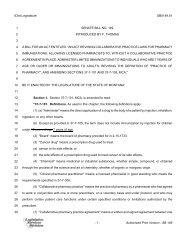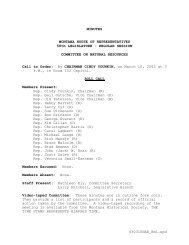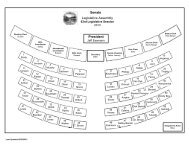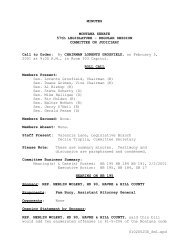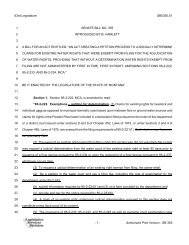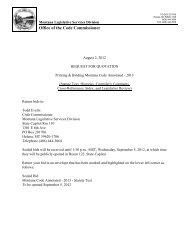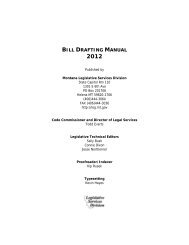Public Comment. Volume III - Montana Legislature
Public Comment. Volume III - Montana Legislature
Public Comment. Volume III - Montana Legislature
You also want an ePaper? Increase the reach of your titles
YUMPU automatically turns print PDFs into web optimized ePapers that Google loves.
Impact Analysis Studies and Proposed Mitigation Approach Page 3<br />
2.0 Current Production Level<br />
MCFH produces fiy, fingerling, and catchable size fish for reservoir stocking and<br />
research activities. Production has increased significantly over the years, and the hatchery<br />
is currently capable of producing approximately 70 million fish per year of various sizes<br />
and species. Although MCFH produces mainly walleye, bass, and northern pike, they are<br />
also called upon to supplement forage fish supplies, cold water species, and other species<br />
as required by MT DFWP regional biologists.<br />
Production success is often defined as the number of fish that are reared to a given size<br />
by species compared to the number of eggs or fish with which the hatchery begins each<br />
production run (Piper et al. 1982). For example, if the hatchery receives 1000 eggs and<br />
. rears 900 of them to the first stockable size, then they have achieved 90% production<br />
success for that stage. For bass species, production success is measured in terms of the<br />
number of fry produced per breeding pair. Fish hatcheries are biological systems and<br />
production success can be highly variable. Climate, water quality, egg coddition, feed<br />
quality and supply, and stock density are just a few of the many factors that can affect<br />
how well a year class of fish does at a hatchery (Piper et al. 1982). In addition, MCFH<br />
has experienced significant growth and construction since its initial dedication as a warmwater<br />
hatchery, and has only recently been able to settle into a consistent routine for its<br />
annual production cycle. All of these factors contribute to the wide variation in the<br />
number of fish and species produced at MCFH from year to year (Table 1).<br />
Table 1 summarizes total production for some of the more commonly reared species at<br />
the hatchery, and is included to illustrate the annual variation in numbers and proportion<br />
for each species. Table 1 lists continuous records from 1985 through 1999.<br />
Table 1.<br />
Summary of annual production of all life stages reared for walleye,<br />
northern pike, bass, and chinook salmon based on records from 1985 to<br />
1999, at the Miles City Fish Hatchery, <strong>Montana</strong>. Blank cells indicate<br />
years where a species was not produced.<br />
Year 1985 1986 1987 1988 1989<br />
Fish Species<br />
Walleye 13,324,192 12,520,974 2,400 32,864,944 4 1,908,702<br />
Northern pike 3,725,050 7,15 1,625 2,675,000 171,752<br />
Largemouth bass 85,454 600,638 - 518,300. 300,9 10<br />
-,.<br />
Smallmouth bass 62,185 , 248,640<br />
Chinook salmon<br />
-224- <strong>Volume</strong> Ill: <strong>Public</strong> <strong>Comment</strong>



